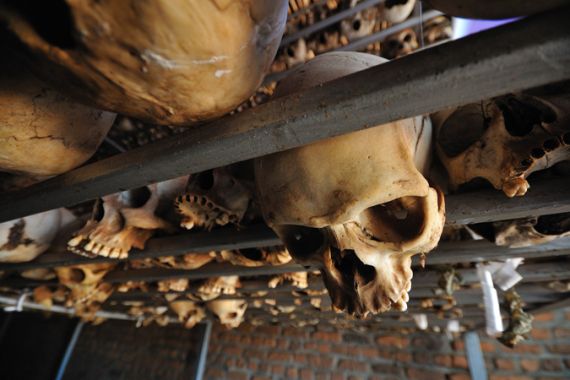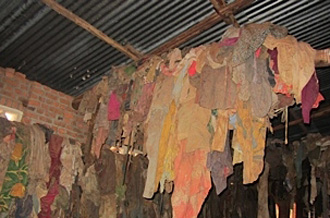Remembering Rwanda’s genocide
As the country celebrates 50 years of independence, Ntarama church commemorates the 5,000 people massacred inside.

Kigali, Rwanda – About an hour’s drive south of Rwanda’s capital city stands Ntarama church – a small, red-brick Catholic place of worship. Yet its unassuming exterior shrouds a darkness within – for Ntarama is also a memorial site, commemorating one of the most brutal acts this country has ever witnessed.
It has been 18 years since 5,000 civilians took refuge in the church in the first weeks of the Rwandan genocide. On April 15, 1994, Hutu paramilitaries unleashed a bloodbath, slaughtering every person they could find. The country which suffered so heavily during the genocide today celebrates its 50th Independence Day, while the Ntarama church stands as a mute spectator.
 |
| A huge pile of bones and skulls of the genocide victims at the Ntarama church in Rwanda [Catherine Wambua/Al Jazeera] |
Anybody visiting the site may simply freeze at the entrance, as one first sees the stacks of human skulls and bones along the back . Hanging on walls and lines along the length of the church are clothes – covered in soot and dirt – which were worn by the victims. The coffins in front of the church house more skeletons. Relatives and visitors passing through pay their respects, placing bouquets of flowers upon them.
The Ntarama church is dark and full of history. Under orders from the Rwandan army and the Interahamwe militia, Hutu gangs systematically set out to massacre all Tutsis, regardless of age or gender. They blew up homes using grenades, hacked, smashed or burnt Tutsis to death everywhere, including inside churches. During the course of approximately 100 days, an estimated 800,000 people were killed.
The Ntarama church, considered to be sacred and safe, turned out to be a massacre ground, as were hundreds of other churches, stadiums and public gathering places across the country. Prior to 1994, nobody dared to attack a church – and thousands fled to churches to escape the machete blows. It is believed that the genocide organisers encouraged the victims to take refuge in the church.
The cruel act of the army is visible in the building – which doubled up as a school on Sundays – situated in the backyard of the Ntarama church. It was where the babies were killed, and the walls remain smeared with their blood.
Valentine Ndamage, the 26-year-old curator of the memorial site, is still trying to understand his country’s brutal past. Ndamage was not in Rwanda during the genocide, as his family moved to the Democratic Republic of Congo before he was born. They came back to Rwanda when he was eight, just a month after the genocide ended.
 |
| Clothes of the victims at the Ntarama church [Catherine Wambua/Al Jazeera] |
“I remember corpses in Gisenyi [a town on the border with DR Congo]. There were bodies everywhere. And the smell. We stayed in Gisenyi for several days. The first day, we spent the night at the College of Gisenyi. There were corpses in all the rooms – my father had to clear one room to create space for us to sleep,” he remembered.
Reconciliation
There has been some reconciliation between the two communities, visible when Angelique Mukabucyza, a Tutsi who lost her two children, and Karereza Bonaventure, a Hutu who was accused of participating in the genocide, were seen shaking hands politely outside the Ntarama church.
The government has been consistent on reconciling the communities. One of the most effective means was the Gacaca court system, a grassroots court where perpetrators and victims sat together to discuss what had happened. The Gacaca closed earlier this month after handling nearly two million cases. The government said that more than 50 per cent of the cases were successfully concluded, leading to convictions.
Angelique went through the Gacaca courts and saw the man who led others to her, killed her two-and-a-half-year-old baby and wounded her with a machete, leaving her to bleed to death. His punishment was hard labour. He later visited Angelique’s home and explained what happened on that day and sought her forgiveness. When asked if the Gacaca court had helped her heal her wounds, Angelique said: “I forgive my attackers; the alternative is a lifetime of hatred.”
However, many have questioned the Gacaca court system. Over the years, human rights organisations have raised concerns over the qualification of the judges and lack of proper defence for the accused.
| Verdict still out on Gacaca courts, ten years on |
Rwanda’s justice minister Tharcisse Karugarama said that there were no other viable options at the time. “We had no money, no judges, no prosecutor, no police investigators. There were numerous people arrested and victims demanding justice. There were only three options – use the western justice system (but we had no professionals), let the citizens take charge – and revenge – or start the Gacaca.”
Moving on
The country has come a long way. It has particularly done well for itself over the past 18 years. It has earned the status of “one of Africa’s success stories”, has boasted high economic growth rates and has a formidable development track record. The country, today, is stable and peaceful.
But then, this has been dampened by a homegrown style of democracy, which has attracted international criticism for being authoritarian.
In Bugesera, as in many parts of the country – people are moving on as best as they can. But there always seems to be suppressed fear within. They are still struggling to come to terms with their history.
Valentine Ndamage believes that the only people who can totally change ideologies are the younger generation. However, “there’s too much water under the bridge for those who lived through the genocide”, he said.